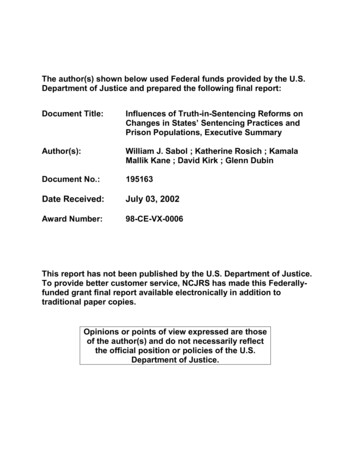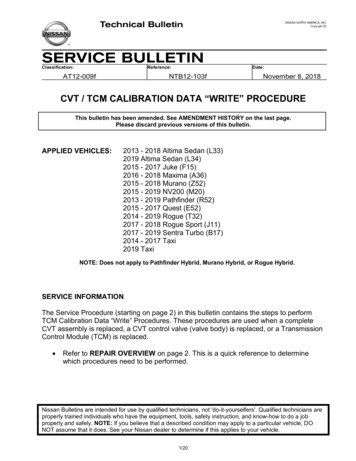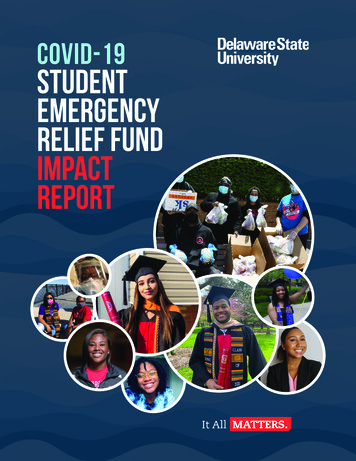
Transcription
The author(s) shown below used Federal funds provided by the U.S.Department of Justice and prepared the following final report:Document Title:Influences of Truth-in-Sentencing Reforms onChanges in States’ Sentencing Practices andPrison Populations, Executive SummaryAuthor(s):William J. Sabol ; Katherine Rosich ; KamalaMallik Kane ; David Kirk ; Glenn DubinDocument No.:195163Date Received:July 03, 2002Award Number:98-CE-VX-0006This report has not been published by the U.S. Department of Justice.To provide better customer service, NCJRS has made this Federallyfunded grant final report available electronically in addition totraditional paper copies.Opinions or points of view expressed are thoseof the author(s) and do not necessarily reflectthe official position or policies of the U.S.Department of Justice.
Executive SummaryTruth in sentencing refers to a range of sentencing practices that aim to reduce the uncertainty aboutthe length of time that offenders must serve in prison. During the 1990s, throughout the states and in thefederal government there was considerable legislative activity related to truth in sentencing. By 1999,41states and the District of Columbia had passed laws or implemented some form of truth in sentencing, butthe forms of truth in sentencing varied among the states. Overall, 29 of these jurisdictions requiredoffenders to serve at least 85 percent of their imposed sentence, while 14 had other truth-in-sentencingrequirements. And although all states’ truth-in-sentencing policies regulated offenders’ time to be servedin relation to the imposed sentence, they used different methods to do so. For example:9.IThe base sentence to which the percentage to be served might be determinate or indeterminate,and for states with indeterminate sentences, the percentage requirements could apply to eitherthe minimum or maximum sentence.Most states required that offenders serve at least 85 percent of their imposed sentences, but thepercentage requirements ranged from 25 percent to 100 percent.Some states eliminated parole release and imposed determinate sentences, thereby permittingrelatively precise calculations of release dates, assuming that good time credits were earned.Other states retained parole release, thereby potentially introducing ambiguity into thecalculation of actual release dates while increasing the certainty about a minimum amount oftime that must be served prior to release.States differed on the types of offenses that were subject to truth-in-sentencing requirements. Insome states, all or most felony offenses were subject to truth in sentencing. In others, truth insentencing was limited to the FBI’s Part 1 violent offenses; still others included misdemeanoroffenses.At the federal level, the Violent Crime Control and Law Enforcement Act of 1994 (“the CrimeAct”), as amended in 1996, provided for federal incentive grants to encourage states to expand theirprison capacity for the purpose of incarcerating violent offenders. The grants were provided through twoprograms: the Violent Offender Incarceration and the Truth-in-Sentencing (VOI/TIS) Incentive GrantsPrograms. To receive VOI funding, a state only needed to give assurances that it had or would implementpolicies that ensured that violent offenders served a substantial portion of their sentences, that madepunishment for violent offenses sufficiently severe, that assured that time served was appropriately relatedto the violent offender’s status, and to protect the public. States that met these requirements could receivesome funding and all states did receive funding under these criteria. States could enhance their VOIfunding by demonstrating that they increased punishment for violent offenders.According to the Crime Act, as amended in 1996, to become eligible to receive TIS funding, stateshad to demonstrate: (1) that they had certain truth-in-sentencing laws in effect; or (2) that they had passedtruth-in-sentencing laws that that would be implemented within three years of their application for federalTIS funds; or (3) if they were states with indeterminate sentencing, that they had demonstrated thatviolent offenders serve on average not less than 85 percent of the prison term established by the state’ssentencing and release guidelines, or that violent offenders serve on average not less than 85 percent ofthe maximum sentence imposed.Executive Summary: Influence of Truth-in-sentencingReforms on States’ Sentencing Systems 1This document is a research report submitted to the U.S. Department of Justice. This report has notbeen published by the Department. Opinions or points of view expressed are those of the author(s)and do not necessarily reflect the official position or policies of the U.S. Department of Justice.
bAs originally enacted in 1994, 7.9 billion was authorized for appropriation as VOI and TIS grants tothe states. Between 1996 and 1998, 6.9 million had been awarded as TIS grants (and another 6.8million as VOI grants). By the end of 1999,28 states and the District of Columbia had received federalTIS grants. Participation in the program was relatively stable, as 25 of the grantee states received theirawards in fust year of funding in 1996, and only 4 new jurisdictions joined the grantee roster in lateryears. In general, the amount of the TIS grants was relatively small (about 1 percent) in relation to thestates’ average annual corrections expenditures.About this studyIn 1998, the Urban Institute was awarded a grant (Mu# 98-CE-VX-oooO6) to study the impacts oftruth in sentencing on changes in the length of stay in prison and, consequently, on the size of state prisonpopulations. The study was designed to measure several types of effects, including the extent of influenceof the Federal sentencing reforms on state truth in sentencing and the effects of state reforms on length ofstay in prison. The two main issues for the study therefore were:t1. Was there an influence of the federal TIS sentencing reforms on states’ truth-in-sentencing lawsand practices, and if so, how large was the influence? For example, did the federal reforms helpto reduce the variation in truth-in-sentencing practices among the states and lead towardsmovement towards a common model? Or, did the federal grant program provide incentives for awide variety of forms of truth in sentencing, and therefore reflect the heterogeneity ofcontemporary American sentencing?2. As one of the aims of truth in sentencing is to increase the severity of sentencing for violentoffenders, did the truth-in-sentencing reforms implemented in several states result in changes insentencing practices that also had impacts on states’ prison populations?bThe research team conducted a comprehensive review of legislative activity leading to the enactmentof the TIS provisions in federal law. We also conducted an extensive review of state sentencing reformsrelated to truth in sentencing, and of grant applications of states that received federal TIS grants. Thesereviews identified the timing of state and federal reforms, described state sentencing reform processes andhow truth in sentencing related to ongoing reforms, and provided information leading to thecategorization of state truth-in-sentencing reforms and analysis of the extent of change associated with thereforms. The study team also conducted in-depth, open-ended interviews with state officials in severalstates and telephone interviews with officials in other states. These interviews improved theunderstanding of how the states responded to federal TIS incentives. Finally, the study conducted aquantitative analysis of the change in “expected” prison outcomes (e.g., expected length of stay andexpected prisoner populations) in an effort to measure the impacts of state truth-in-sentencing practices onstate prisoner populations. Data from one state, from the Bureau of Justice Statistic’s NationalCorrections Reporting Program, and the FBI Uniform Crime Reports were analyzed using offensespecific disaggregated flow models and mathematical decomposition methods to estimate the impact of“pre-sentencing” factors (such as changes in offenses and arrests), of sentencing decisions (such as theprobability of imprisonment given arrest), and truth in sentencing (the percent of sentence served) onexpected length of stay and the expected prison population.Executive Summary: lnfluence of Truth-in-sentencingReforms on Slates’ Sentencing SystemsThis document is a research report submitted to the U.S. Department of Justice. This report has notbeen published by the Department. Opinions or points of view expressed are those of the author(s)and do not necessarily reflect the official position or policies of the U.S. Department of Justice.2
The Federal TIS Incentive Grant ProgramAs originally enacted under the Crime Act in 1994 and amended by the Department of JusticeAppropriations Act of 1996, states could qualify for federal TIS grants if they demonstrated that they fitany one of five criteria:.States with determinate sentencing could qualify if:They had implemented truth-in-sentencing laws that require persons convicted of Part 1violent offenses to serve not less than 85 percent of the sentence imposed, orThey had implemented truth-in-sentencing laws that result in persons convicted of Part 1violent offenses serving on average not less than 85 percent of the sentence imposed; orThey had enacted but not yet implemented truth-in-sentencing laws that would beimplemented within three years of their application date that required persons convicted ofPart 1 violent offenses to serve not less than 85 percent of the sentence imposed.States with indetenninate sentencing could qualify if:They demonstrated that persons convicted of Part 1 violent offenses serve, on average, notless than 85 percent of the prison term established under the state’s sentencing and releaseguidelines; or They demonstrated that persons convicted of Part 1 violent offenses serve on average not lessthan the maximum prison term allowed under the sentence imposed by the court.’These criteria have guided the decision-making of the TIS grant program since its inception in 1996.Although the VOVTIS grant program was established by law through the Crime Act in 1994, it was notimplemented until 1996, when funds were appropriated by the Department of Justice Appropriations Actof April 26, 1996. The Appropriations Act also amended Subtitle A of the Crime Act. Truth insentencing as set forth in the Appropriations Act of 1996 is therefore appreciably different from the 1994provisions, most notably with the introduction of criteria for indeterminate sentencing states, with theelimination of a provision requiring that truth in sentencing be applied to repeat violent or serious drugoffenders, and with the introduction of the definition of violent crimes as Part 1 violent crimes.Influences of the Federal TIS reforms on state truth-in-sentencingpoliciesThe 1996 changes to the federal TIS grant eligibility requirements - particularly the expansion of theeligibility criteria to address indeterminate sentencing - made it possible for all states to participate in thefederal grant program The changes in the criteria also allowed states to participate in the grant programwithout making substantive changes to their truth-in-sentencing laws. These changes raise the question: Towhat extent did the federal TIS reforms influence state reforms or did the federal reforms reflect statesentencingreforms that were already implemented or well in progress?bbBy the end of 1999,42 jurisdictions - 41 states and the District of Columbia - had some form oftruth-in-sentencing laws and an additional state (Utah)received a truth-in-sentencing grant withoutspecific truth-in-sentencing laws. A total of 29 jurisdictions - 28 states and the District of Columbia received TIS grants between 1996 and 1999. Twenty-two grantee states qualified under eligibility criteriathat were established under the original 1994 law, while an additional six states - California, Delaware,Michigan, Oklahoma, Pennsylvania, Utah - qualified because of the expansion of the eligibility criteria’ See Department of Justice Appropriations Act, 1996, PL 104-134 0 20104 (a).Executive Summary: Influence of Truth-in-sentencingReforms on States’ Sentencing SystemsThis document is a research report submitted to the U.S. Department of Justice. This report has notbeen published by the Department. Opinions or points of view expressed are those of the author(s)and do not necessarily reflect the official position or policies of the U.S. Department of Justice.3
under the 1996 Amendment. The District of Columbia qualified because the National CapitalRevitalization and Self-Government Improvement Act of 1997, which established the District’s Truth-inSentencing Commission, set forth the requirements for sentencing reform in the District.*Exhibit 1 shows the forms of truth in sentencing that are practiced in the states, and the extent to whichstate-level truth in sentencing changed following the passage of the 1994 Crime Act. Thirty states did notchange their truth-in-sentencing laws at all, and the remaining 21 jurisdictions (20 states plus the District)changed their truth-in-sentencing laws to varying degrees. Exhibit 1 crossclassifies the states and theDistrict of Columbia according to their pre-Crime Act truth-in-sentencing laws (down the left hand-sidecolumn) by their truth-in-sentencing laws enacted during the 1995-1999 period. Furthermore, eachjurisdiction’s truth-in-sentencing laws are classified according to two criteria: (1) whether they allow forparole release of violent offenders, or the degree of determinacy in their release decisions; and (2) whetherthey required violent offenders to serve at least 85 percent of their imposed sentence. These two criteriaresult in the five categories or “forms of TIS” represented in the table:.tIDNo parole release for violent offenders:o Statutory requirements that at least 85 percent of the determinate or maximum sentencebe served. Violent offenders must serve at least 85 percent of their imposed determinate(or fixed) sentences with no parole release; up to 15 percent of the sentence may beearned by good conduct credits.o Statutory requirements that some other specific percentage - less than 85 percent - ofthe determinute or maximum sentence be served. This is similar in all respects to theprevious model, except that the percentage requirement is below 85 percent.Parole release for violent offenders:o Statutory requirements that at least 85 percent of the determinate or maximum sentencebe served. Offenders are generally eligible for parole once they have served 85 percentof the sentence (either a fixed term or the maximum term of an indeterminate sentence),but actual date of release is at the discretion of the parole board; offenders may be heldbeyond 85 percent of the imposed term.o Statutory requirementsfor another specific percentage of the minimum or maximumsentence be served. Offenders are eligible for parole release after serving a requiredpercentage of their sentences; the requirement frequently applies to the minimum term ofan indeterminate sentence range.No statutory TIS requirements. States may have policies related to the time that offenders servein prison, but there are no truth-in-sentencing laws requiring a certain percentage of the sentenceto be served.Following the enactment of the TIS grant program, 30 states made no changes to their truth-insentencing laws; another 7 states made only modest changes to the percentage of sentence to be served byviolent offenders; five states modified their truth-in-sentencing laws by both increasing the percentage ofsentence to be served requirements and eliminating parole release decisions; and nine states that had notruth-in-sentencing laws prior to 1994 passed sentencing reforms that included truth-in-sentencingprovisions. In most of these states, the sentencing reform process began prior to the Crime Act.For more on the truth-in-sentencingreforms in the District of Columbia, see: William J. Sabol and James P. Lynch(2001). Sentencing and Time Served in the District of Columbia Prior to Truth in Sentencing: Final Report.Submitted to the National Institute of Justice, Washington, D.C.,July. See also: Report ofthe Disrrict of ColumbiaAdvisory Commission on Sentencing, April 5,2000.Executive Summary: Influence of Truth-in-sentencingReforms on States’ Sentencing Systems 4This document is a research report submitted to the U.S. Department of Justice. This report has notbeen published by the Department. Opinions or points of view expressed are those of the author(s)and do not necessarily reflect the official position or policies of the U.S. Department of Justice.
There was wide variation in the forms of TIS practiced by the 30 states that made no changes to theirTIS legislation (on the shaded diagonal). Starting in the upper left comer, eight states - Arizona,California, Georgia, Minnesota, North Carolina, Oregon, Virginia, and Washington State - retaineddeterminate sentences for violent offenders, required that at least 85 percent of the sentence be served,and did not allow parole release. These states generally passed their TIS laws between 1990 and 1994.3Two states - Alaska and Delaware - retained their pre-1994 truth-in-sentencing structure of determinatesentences, a less than 85 percent of the sentence requirement, and no parole release. Delaware, forexample, has not altered its no parole release policy, in effect since 1990, or its 1993TIS law requiring 75percent of the sentence to be served. Although Delaware’s law specifies 75 percent as the standard to beserved, it qualified for a federal TIS grant by demonstrating that violent offenders actually served, onaverage, at least 85 percent of the imposed sentence.I11Among indeterminate sentencing states, one state - Missouri - retained parole release, but it requiredthat “dangerous felons” serve 85 percent of the maximum term before becoming eligible for parolerelease. Ten other states - Arkansas, Colorado, Massachusetts, Maryland, Michigan, Nebraska, NewHampshire, Nevada, Pennsylvania, and Texas - retained percentage requirements other than an 85 percentrequirement and use parole release. The percentage may be based on either the minimum or maximumterm, as in New Hampshire, for example, offenders have been required since 1982to serve 100 percent oftheir minimum sentence before becoming eligible for parole release.Finally, nine states had no truth-in-sentencing laws before the Crime Act and they did not pass truthin-sentencing laws after the Crime Act. In these nine - Alabama, Hawaii, New Mexico, Rhode Island,South Dakota, Utah, Vermont, West Virginia, and Wyoming - the amount of time offenders serve inprison may be regulated by other means. For example, Utah has used a voluntary sentencing guidelinesstructure since 1985 to guide both sentencing and parole release decisions!The remaining twenty states and the District of Columbia made at least modest changes to theirtruth-in-sentencing policies following the passage of the 1994 Crime Act. In all of these states, thechanges served to tighten restrictions on the release of violent offenders; for example, the states generallyincreased the percentage of sentence that violent offenders had to serve. Some states also eliminatedparole release for violent offenders. Most of the reforms were incremental or marginal modifications toexisting statutes. But in nine jurisdictions, major changes in sentencing structure occurred.?U.S.General Accounting Office. 1998. Truth in Sentencing: Availability of Federal Grants Influenced Laws inSome States. Washington, DC: U.S. General Accounting Office. GAO/GGD-98-42. February.bb.Half of the states described here enacted their TIS laws before 1994: Arizona (1993), Minnesota (1992). NorthCarolina (1993), and Washington State (1990). Of those enacted in 1994, Georgia’slaw was p a s d well before thefederal 1994 Crime Act, on 3130194. The remaining states with TIS laws passed in 1994 were enacted within twomonths the 9/13/94 passage of the Crime Act: California (9/21/94),Oregon (1 1/94), and Virginia (9/30/94). Sincethese bills would have been drafted in advance of the passage of the Crime Act, the influence of specific provisionsof the Crime Act are considered to be minimal.4Utah is a special case. Exhibit 1 classifies it as voluntary, having no truth-in-sentencing laws. However, Utahpractices a form of truth in sentencing within its system of sentencingand release guidelines. This sentencingstructure, implemented in 1985, remained essentially the same throughout the 199Os, although the sentencerecommendations have been revised over time.Executive Summary: lniluence of Truth-in-sentencingReforms on States’ Sentencing SystemsThis document is a research report submitted to the U.S. Department of Justice. This report has notbeen published by the Department. Opinions or points of view expressed are those of the author(s)and do not necessarily reflect the official position or policies of the U.S. Department of Justice.5
Seven states increased the percent of sentence served. The changes in Connecticut, Florida, Illinois,Kansas, Kentucky, Louisiana and Maine were incremental changes to their existing truth-in-sentencinglaws consisting of increases to the percentage of sentence to be served by violent offenders with no otherchanges to the truth-in-sentencing structure. Kansas, for example, maintained its detenninate, no parolestructure, but changed its 1993 TIS law from an 80 percent requirement to an 85 percent requirement in1995. Similarly in Connecticut, a 1993 TIS requirement for offenders to serve 50 percent of theirsentences before becoming eligible for parole release was increased to 85 percent in 1995.Five jurisdictions - the District of Columbia: Mississippi, New York, Tennessee, and Wisconsin made larger changes to their truth-in-sentencing structure. In addition to increasing the percentage ofsentence served requirements, they also altered their release mechanisms by eliminating parole for violentoffenders. In Mississippi prior to 1995, for example, offenders were eligible for parole after theycompleted 25 percent of their sentences. The new law, passed in 1995, abolished parole and the percentof sentence to be served was increased to 85 percent. In most of these states, prior to the federal TISprogram, truth in sentencing existed within an indeterminate sentencing framework, and the percentagerequirements were usually less than 85 percent. The reforms enacted after 1994 not only increased thepercentage requirement, but also reduced indeterminacy by eliminating parole release for violentoffenders.fThe District of Columbia is a special case. In addition to increasing requirements and eliminatingparole, it also undertook a comprehensive sentencing reform process. However, the sentencing reforms inthe District were the direct result of the National Capital Revitalization Act of 1997. Prior to this Act, theDistrict’s truth-in-sentencing provisions were limited to mandatory minimum requirements for selectedclasses of violent offenders. For example, in 1992, the mandatory minimum amount that personsconvicted of first-degree murder were required to serve prior to parole release eligibility was increasedfrom 20 to 30 years. The Revitalization Act established the District’s Truth-in-Sentencing Commissionand required it to make recommendations to the Council of the District of Columbia about the sentencingof felony offenders. The Act also required the Commission’s recommendations to meet the truth-insentencing standards of section 20104 (a) (1) of the Crime Act!Nine states - Idaho, Indiana, Iowa, Montana, New Jersey, North Dakota, Ohio, Oklahoma, and SouthCarolina - had no truth-in-sentencing requirements prior to the 1994 Crime Act, but each passed theirfirst truth-in-sentencing laws between 1995 and 1999. Most of these states incorporated an “85 percentrule” into their new truth-in-sentencing laws, including Iowa, New Jersey, North Dakota, Ohio,Oklahoma, and South Carolina, but Idaho, Indiana, and Montana adopted lower percentage requirements.Among the “85 percent” states, Iowa and Ohio also abolished parole (to different degrees) while the restincorporated truth in sentencing into their existing parole release structures. Though the specifics of thechanges differed from state to state, in all nine of these states, truth in sentencing represents a significantshift from the past practice of how offenders were released from prison.Several of these nine “major change” states undertook comprehensive sentencing reform thatcoincided with the federal TIS reforms. Ohio, for example, began its reform effort as early as 1991, whenthe General Assembly instructed the Ohio Criminal Sentencing Commission to develop a sentencing planLBut, as indicated previously, the District of Columbia’s reforms were initiated by the federal Revitalization Act of1997, rather than by the 1994 Crime Act. The District is a special case of direct Federal influence on its sentencingstructure.See Sabol and Lynch, 2001, op. cit.Executive Summay: Influence of Truth-in-sentencingReforms on States‘ Sentencing Systems 6This document is a research report submitted to the U.S. Department of Justice. This report has notbeen published by the Department. Opinions or points of view expressed are those of the author(s)and do not necessarily reflect the official position or policies of the U.S. Department of Justice.
that considered several goals of sentencing. Most of the main components of Ohio’s sentencing reform,including its 97 percent TIS requirement, were laid out in a 1993 plan for felony sentencing? Subsequentlegislation - Senate Bill 2, which passed in 1995 - established truth in sentencing in Ohio effective July1, 1996. None of these ‘‘major change’’ states reported that they undertook their sentencing reforms inorder to bring themselves into alignment with federal truth-in-sentencing requirements.Among the 21 states that made changes to their truth-in-sentencing structure, the federal TISprogram was reported (according to a GAO survey) to be a key factor in implementing the reforms in 5states, but in these 5 states, the changes typically were modifications to the percent of sentence served.8In 10 of the 21 states, the federal program was reported to be a partial factor, and these states generallychanged both the percentage requirements and method of release. In the remaining 6 of the 21 “changestates,” the federal program reportedly had no influence on their changes.In sum, this analysis of state sentencing reforms indicates that, overall, the federal TIS grant programhad relatively minor influence on state truth-in-sentencing policies. A relatively small number of statesmade large changes to their pre-1994 truth-in-sentencing structure, and for the most part, these changescan be explained in terms of ongoing sentencing reform processes in those states. The review showedthat 30 states made no changes to their truth-in-sentencing policies, and another 11 made only modestchanges. The 10 states that made substantial truth-in-sentencing reforms generally began their sentencingreforms before the implementation of the federal grant program, and truth in sentencing was incorporatedinto their reforms for a variety of reasons. In the special case of the District of Columbia, other federallegislation led to wholesale changes in sentencing structure that resulted in a new truth-in-sentencingstructure.Impacts on state prison populationsThe second major research question in this study related to whether the truth-in-sentencing reformsthat were adopted in the states had impacts on their prison populations. The truth-in-sentencing reformsimplemented throughout the states generally aimed to increase the certainty of punishment for violentoffenders by reducing the apparent disparity between sentence imposed and time served.ITo examine the effects of truth in sentencing on prison populations, a cross-state, case-studyapproach was used to analyze changes over-time in prison population outcomes in seven states, Georgia,Illinois, New Jersey, Ohio, Pennsylvania, Utah, and Washington. These states had various forms of truthin sentencing that were implemented within different sentencing structures. Each state, nevertheless, wasselected from one of three forms of truth in sentencing: (1) determinate sentencing states with a rulerequiring violent (or all) offenders to serve 85 percent of their imposed sentences; (2) indeterminatesentencing states with truth-in-sentencing statutory provisions; and (3) an indeterminate sentencing statethat implemented truth in sentencing through expectations about minimum terms and its release practices.Within these three broad forms, there was variation in the way truth in sentencing was implemented.Methodology’David Diroll, Executive Director, Ohio Criminal Sentencing Commission. Interview, June 7, 1999. Also, OhioCriminal Sentencing Commission. 1993. A Plan for Felony Sentencing in Ohio.U.S. General Accounting Office, 1998, op. cit.Executive Summary: Influence of Truth-in-sentencingReforms on States‘ Sentencing Systems 7This document is a research report submitted to the U.S. Department of Justice. This report has notbeen published by the Department. Opinions or points of view expressed are those of the author(s)and do not necessarily reflect the official position or policies of the U.S. Department of Justice.
Changes in prison population outcomes were analyzed by decomposing the results obtained fromoffense-specific disaggregated flow models of the incarceration process. These flow models analyzedtransitions or movements between several decision points in this process; including:. .From the general population to the offender population;From offender populations to th
Jul 03, 2002 · truth-in-sentencing laws and an additional state (Utah) received a truth-in-sentencing grant without specific truth-in-sentencing laws. A total of 29 jurisdictions - 28 states and the District of Columbia - received TIS grants between 1996 and 1999. Twent











